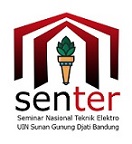Perancangan Antena Ultra-wideband Monopol Planar dengan Struktur UC-EBG
Keywords:
Monopol Planar, Antena Wearable, Ultra-Wideband, UC-EBGAbstract
Teknologi Ultra-wideband atau biasa dikenal UWB merupakan sebuah teknologi wireless yang digunakan untuk mengirim data pada tingkat di atas jarak pendek dengan menggunakan daya yang relatif kecil. Pengaplikasian WBAN menggunakan antena wearable karena memiliki bahan yang fleksibel dan cocok untuk teknologi telemedis serta memiliki banyakkeunggulan seperti ukuran yang kecil, ringan, mampu bekerja pada frekuensi yang cukup lebar,dan pabrikasi yang mudah serta membutuhkan biaya yang terjangkau. Dalam penelitian ini dilakukan perancangan antena wearable monopol planar patch heksagonal dengan frekuensi ultra wide-band rentang 3.1-10.6 GHz dan menggunakan bahan tekstil Cordura Delinova 2000 untuk bagian substrat, coppertape untuk bahan konduktor groundplane dan patch. Ditambahkan metode UC-EBG pada perancangan antena monopol planar pada penelitian ini yang bertujuan untuk meningkatkan parameter antena, meningkatkan gain, dan mengurangi back radiation. Pada penelitiam ini dilakukan analisis performansi pada antena dengan melakukan beberapa perubahan posisi UC-EBG untuk mendapatkan antena dengan spesifikasi paling baik. Setelah dilakukan simulasi dengan perhitungan yang ada, diperoleh hasil parameter antena yang ditinjaudi frekuensi 5GHz dengan Return Loss sebesar -16.55, nilai VSWR sebesar 1.349, nilai gain sebesar 4.754 dBi, dan nilai SAR sebesar 1.277 W/Kg.
Ultra-wideband technology or commonly known as UWB is a wireless technology thatis used to transmit data at rates over short distances using relatively little power. The applicationof WBAN uses a wearable antenna because it has flexible materials and is suitable for telemedicine technology and has many advantages such as small size, lightweight, able to work on a fairly wide frequency, easy manufacturing and requires affordable costs. In this research, the design of a hexagonal planar patch wearable monopole antenna with an ultra wide-band frequency range of 3.1-10.6 GHz was carried out and used Cordura Delinova 2000 textile material for the substrate, copper tape for the groundplane and patch conductors. The UC-EBGmethod is added to the planar monopole antenna design in this study which aims to increase theantenna parameters, increase gain, and reduce back radiation. In this study, performance analysis was carried out on the antenna by making several changes to the position of the UC- EBG to get the antenna with the best specifications. After performing the simulation with the existing calculations, the results of the antenna parameters that are reviewed at the 5GHz frequency are obtained with a Return Loss of -16.55, a VSWR value of 1.349, a gain value of 4.754 dBi, and a SAR value of 1.277 W/Kg.
Downloads
References
I Tomic, JA McCann. 2017. "A Survey of Potential Security Issues in Existing Wireless sensor network Protocols". IEEE Internet of things Journal (Volume: PP, Issue: 99)
Kiran, P Ahlawat. 2015. "A Review on Wireless body area network". IJSER Volume 3Issue 6 pp 72-75
SMR Islam, et al. 2015. “The Internet of things for Health Care: A Comprehensive Survey”. IEEE Access Volume 3 pp 678-708
D. P. Wulandari, H. Wijanto, and E. Edwar, “Design Of An Ultra Wideband Antenna For Noncontact Respiratory Monitoring,” 2018, pp. 4–5.
A. Tariq, Vital Signs Monitoring using Doppler Radar and on-body Antennas. 2012.
Augustine, Robin. 2009. “Electromagnetic modeling of human tissues and its applicationon the interaction between antenna and human body in the BAN context”. Universite – Paris–Est.
R. Retdiwalgi, A. Muayyadi, and Ali, Antena Ultra Wideband Mikrostrip SegiEmpat untuk Aplikasi Medis. Bandung, 2019.
K. P. Ray, “Design Aspects of Printed Monopole Antennas for Ultra-Wide Band Applications,” Int. J. Antennas Propag., vol. 2008, pp. 1–8, 2008, doi: 10.1155/2008/713858.
Y. Manwal, S. Bisht, S. Kumari, S. Rai, and B. Chauhan, “Literature ReviewOn Wearable Textile Antennas,” pp. 35–39, 2016.
Susilawati, T. Yunita, and L. N. Olivia, “ANTENA MIKROSTRIP BAHANTEKSTIL PATCH SEGI EMPAT PADA FREKUENSI 5-6 GHz,” vol. 5, no. 3, pp. 4597–4604, 2018
S. K. Kamepally, B. P. Kumar, and C. S. Paidimarry, “FDTD estimation foraccurate specific absorption rate in tumor,” 2013.
H. Hamouda, P. Le Thuc, R. Staraj, and G. Kossiavas, “Small antenna embedded in a wristwatch for application in telemedicine,” 8th Eur. Conf. Antennas Propagation, EuCAP2014, no. EuCAP, pp. 876–879, 2014, doi: 10.1109/EuCAP.2014.6901902.
“An Internet resource for the calculation of the Dielectric Properties of BodyTissues inthe frequency range 10 Hz - 100 GHz.” http://niremf.ifac.cnr.it/tissprop/.
V. A. Ridho, S. B. Utomo and D. Setiabudi, "Perancangan dan Realisasi Antena Mikrostrip 700MHz Model Patch Circular Dengan Metode Linear Array Sebagai Penerima TV Digital," Elektronik Jurnal Arus Elektro Indonesia, p. 5.
Monirujjaman Khan, Mohammad,” Antenna and Radio Channel Characterisation for LowPower Personal and Body Area Networks”, Thesis, United Kingdom : Queen Mary, University of London, February 2012.
K.P. Ray, "Design Aspects of Printed Monopole Antennas for Ultra-Wide Band Applications," International Journal of Antennas and Propagations, p. 8, 2008.
M. S. Alam, N. Misran, B. Yatim, and M. T. Islam, “Development of electromagnetic band gap structures in perspective of microstrip antenna design,” Int. J. Antennas Propag., vol.2013, 2013, doi: 10.1155/2013/507158.
Cripps, Steve C. Electromagnetic Band Gap Structures in Antenna Engineering, (2009).



